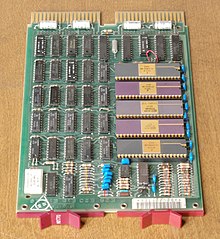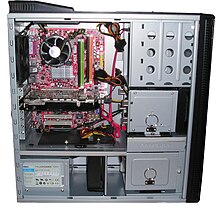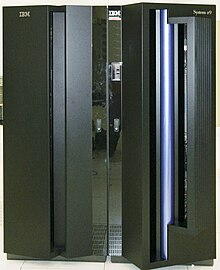Computer hardware: Difference between revisions
m Reverted edits by 183.82.97.144 (talk) to last version by Sandshark23 |
No edit summary |
||
| Line 2: | Line 2: | ||
[[File:PDP-11-M7270.jpg|thumb|[[PDP-11]] CPU board]] |
[[File:PDP-11-M7270.jpg|thumb|[[PDP-11]] CPU board]] |
||
'''Computer hardware''' is the collection of physical elements that constitutes a [[computer]] system. Computer hardware refers to the physical parts or components of a computer such as the [[computer monitor|monitor]], [[Mouse (computing)|mouse]], [[computer keyboard|keyboard]], computer [[Computer data storage|data storage]], [[hard drive]] disk (HDD), system unit (graphic cards, sound cards, memory, motherboard and chips), etc. all of which are physical objects that can be touched.<ref>{{cite web |title=Parts of computer |url=http://windows.microsoft.com/en-us/windows-vista/parts-of-a-computer |publisher=Microsoft |accessdate=5 December 2013}}</ref> In contrast, [[software]] is instructions that can be stored and run by hardware. |
'''Computer hardware shobhit gupta''' is the collection of physical elements that constitutes a [[computer]] system. Computer hardware refers to the physical parts or components of a computer such as the [[computer monitor|monitor]], [[Mouse (computing)|mouse]], [[computer keyboard|keyboard]], computer [[Computer data storage|data storage]], [[hard drive]] disk (HDD), system unit (graphic cards, sound cards, memory, motherboard and chips), etc. all of which are physical objects that can be touched.<ref>{{cite web |title=Parts of computer |url=http://windows.microsoft.com/en-us/windows-vista/parts-of-a-computer |publisher=Microsoft |accessdate=5 December 2013}}</ref> In contrast, [[software]] is instructions that can be stored and run by hardware. |
||
Software is any set of machine-readable instructions that directs a computer's processor to perform specific operations. A combination of hardware and software forms a usable computing system.<ref>{{cite web |last=Smither |first=Roger |title=Use of computers in audiovisual archives |url=http://www.unesco.org/webworld/ramp/html/r9704e/r9704e0x.htm |publisher=UNESCO |accessdate=5 December 2013}}</ref> |
Software is any set of machine-readable instructions that directs a computer's processor to perform specific operations. A combination of hardware and software forms a usable computing system.<ref>{{cite web |last=Smither |first=Roger |title=Use of computers in audiovisual archives |url=http://www.unesco.org/webworld/ramp/html/r9704e/r9704e0x.htm |publisher=UNESCO |accessdate=5 December 2013}}</ref> |
||
Revision as of 19:01, 25 February 2014

Computer hardware shobhit gupta is the collection of physical elements that constitutes a computer system. Computer hardware refers to the physical parts or components of a computer such as the monitor, mouse, keyboard, computer data storage, hard drive disk (HDD), system unit (graphic cards, sound cards, memory, motherboard and chips), etc. all of which are physical objects that can be touched.[1] In contrast, software is instructions that can be stored and run by hardware.
Software is any set of machine-readable instructions that directs a computer's processor to perform specific operations. A combination of hardware and software forms a usable computing system.[2]
Von Neumann architecture

The template for all modern computers is the Von Neumann architecture, detailed in a 1945 paper by Hungarian mathematician John von Neumann. This describes a design architecture for an electronic digital computer with subdivisions of a processing unit consisting of an arithmetic logic unit and processor registers, a control unit containing an instruction register and program counter, a memory to store both data and instructions, external mass storage, and input and output mechanisms.[3] The meaning of the term has evolved to mean a stored-program computer in which an instruction fetch and a data operation cannot occur at the same time because they share a common bus. This is referred to as the Von Neumann bottleneck and often limits the performance of the system.[4]
Different systems
There are a number of different types of computer system in use today.
Personal computer


The personal computer also known as the PC, is one of the most common types of computer due to its versatility and relatively low price. Laptops are generally very similar, although may use lower-power or reduced size components.
Case
The computer case is a plastic or metal enclosure that houses most of the components. Those found on desktop computers are usually small enough to fit under a desk, but many newer computers use more compact designs. Laptops are computers with a clamshell form factor, that fold up into a device that includes an integrated screen.
Power supply
A power supply unit (PSU) converts alternating current (AC) electric power to low-voltage DC power for the internal components of the computer. Laptops are capable of running from a built-in battery, normally for a period of hours.[5]
Motherboard
The motherboard is the main component inside the case. It is a large rectangular board with integrated circuitry that connects the other parts of the computer including the CPU, the RAM, the disk drives(CD, DVD, hard disk, or any others) as well as any peripherals connected via the ports or the expansion slots.
Components directly attached to or part of the motherboard include:
- The CPU (Central Processing Unit) performs most of the calculations which enable a computer to function, and is sometimes referred to as the "brain" of the computer. It is usually cooled by a heat sink and fan. Most newer CPUs include an on-die Graphics Processing Unit (GPU).
- The Chipset, which includes the north bridge, mediates communication between the CPU and the other components of the system, including main memory.
- The Random-Access Memory (RAM) stores the code and data that are being actively accessed by the CPU.
- The Read-Only Memory (ROM) stores the BIOS that runs when the computer is powered on or otherwise begins execution, a process known as Bootstrapping, or "booting" or "booting up". The BIOS (Basic Input Output System) includes boot firmware and power management firmware. Newer motherboards use Unified Extensible Firmware Interface (UEFI) instead of BIOS.
- Buses connect the CPU to various internal components and to expansion cards for graphics and sound.
Expansion cards
The [expansion card] in computing is a printed circuit board that can be inserted into an expansion slot of a computer motherboard or backplane to add functionality to a computer system via the expansion bus.
Storage devices
Computer data storage, often called storage or memory, refers to computer components and recording media that retain digital data. Data storage is a core function and fundamental component of computers.
Fixed media
Data is stored by a computer using a variety of media. Hard disk drives are found in virtually all older computers, due to their high capacity and low cost, but solid-state drives are faster and more power efficient, although currently more expensive than hard drives, so are often found in more expensive computers. Some systems may use a disk array controller for greater performance or reliability.
Removable media
To transfer data between computers, a USB flash drive or Optical disc may be used. Their usefulness depends on being readable by other systems; the majority of machines have an optical disk drive, and virtually all have a USB port.
Input and output peripherals
Input and output devices are typically housed externally to the main computer chassis. The following are either standard or very common to many computer systems.
Input
Input devices allow the user to enter information into the system, or control its operation. Most personal computers have a mouse and keyboard, but laptop systems typically use a touchpad instead of a mouse. Other input devices include webcams, microphones, joysticks, and image scanners.
Output device
Output devices display information in a human readable form. Such devices could include printers, speakers, monitors or a Braille embosser.
Mainframe computer

A mainframe computer is a much larger computer that typically fills a room and may cost many hundreds or thousands of times as much as a personal computer. They are designed to perform large numbers of calculations for governments and large enterprises.
Supercomputer
A supercomputer is superficially similar to a mainframe, but is instead intended for extremely demanding computational tasks. As of November 2013[update], the fastest supercomputer in the world is the Tianhe-2, in Guangzhou, China.[6]
References
- ^ "Parts of computer". Microsoft. Retrieved 5 December 2013.
- ^ Smither, Roger. "Use of computers in audiovisual archives". UNESCO. Retrieved 5 December 2013.
- ^ von Neumann, John (1945). "First Draft of a Report on the EDVAC" (PDF).
{{cite journal}}: Cite journal requires|journal=(help) - ^ Markgraf, Joey D. (2007). "The Von Neumann bottleneck". Retrieved 24 August 2011.
- ^ "How long should a laptop battery last?". Computer Hope. Retrieved 9 December 2013.
- ^ Alba, Davey. "China's Tianhe-2 Caps Top 10 Supercomputers". IEEE. Retrieved 9 December 2013.
External links
 Learning materials related to Computer hardware at Wikiversity
Learning materials related to Computer hardware at Wikiversity Media related to Computer hardware at Wikimedia Commons
Media related to Computer hardware at Wikimedia Commons
